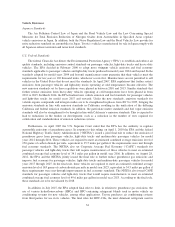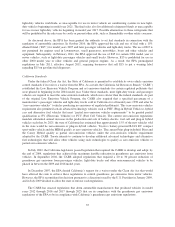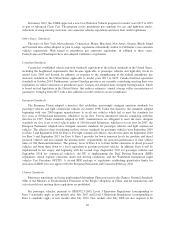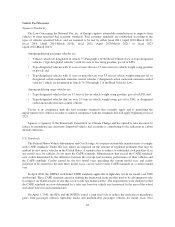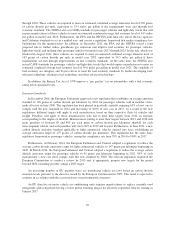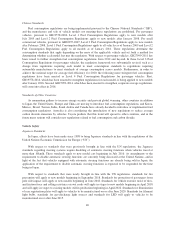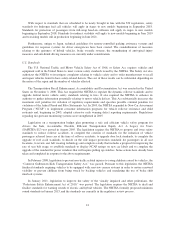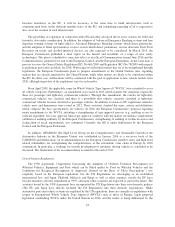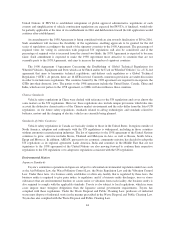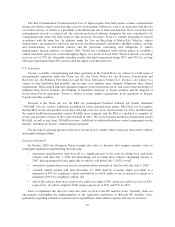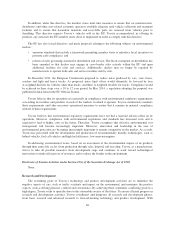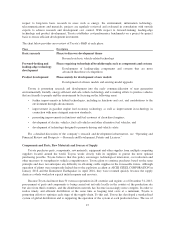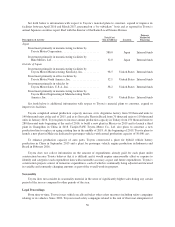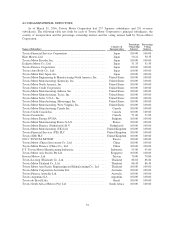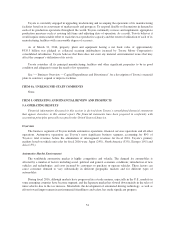Toyota 2015 Annual Report Download - page 49
Download and view the complete annual report
Please find page 49 of the 2015 Toyota annual report below. You can navigate through the pages in the report by either clicking on the pages listed below, or by using the keyword search tool below to find specific information within the annual report.United Nations. If IWVTA is established, integration of global approval administrative regulations of each
country and simplification of vehicle construction regulations are expected but IWVTA, if finalized, would only
be partially applicable at the time of its establishment in 2016 and deliberation toward the full application would
continue after establishment.
An amendment to the 1958 Agreement is being considered with an aim towards finalization of R0 in 2016.
Such amendment will increase the flexibility of the regulations, enabling approvals to be granted for the old
series of regulations according to the needs of the signatory countries to the 1958 Agreement. The percentage of
required votes for voting in connection with proposed UN regulations will also be considered, and if the
percentage of required votes is increased from the current two-thirds, the 1958 Agreement is expected to become
fairer. Such amendment is expected to make the 1958 Agreement more attractive to countries that are not
currently party to the 1958 Agreement, and aims to increase the number of signatory countries.
The 1998 Agreement (“Agreement Concerning the Establishing of Global Technical Regulations for
Wheeled Vehicles, Equipment and Parts which can be Fitted and/or be Used on Wheeled Vehicles”) is a U.S.-led
agreement that aims to harmonize technical regulations, and defines each regulation as a Global Technical
Regulation (“GTR”). At present, there are 16 GTRs in total. Currently, numerous provisions are under discussion
in order to include more regulations. The countries bound by the 1998 agreement are required to incorporate the
GTRs into their domestic laws. The parties to the 1998 agreement include the United States, Canada, China and
India, which are not parties to the 1958 agreement, so GTRs will also influence those countries.
Chinese Standards
Vehicle safety regulations in China were drafted with reference to the UN regulations and cover almost the
same matters as the UN regulations. However, these regulations also include unique provisions which take into
account the distinctive characteristics of the Chinese market environment and the rules differ from the latest UN
regulations. As for future safety regulations, standards related to airbag technologies and standards related to
batteries, motors and the charging of electric vehicles are currently being planned.
Standards of Other Countries
Vehicle safety regulations in Canada are basically similar to those in the United States. In regions outside of
North America, adoption and conformity with the UN regulations is widespread, including in those countries
without automotive manufacturing industries. The list of signatories to the 1958 agreement of the United Nations
continues to grow, and now includes Korea, Thailand and Malaysia in Asia, as well as Russia, South Africa,
Egypt and Morocco. In addition, ASEAN, pursuant to its economic community mission, has decided to adopt the
UN regulations as its regional agreement. Latin America, India and countries in the Middle East that are not
signatories to the 1958 agreement of the United Nations are also moving forward to conform their respective
regulations to the UN regulations or to adopt new regulations consistent with the UN regulations.
Environmental Matters
Japanese Standards
Toyota’s automotive operations in Japan are subject to substantial environmental regulation under laws such
as the Air Pollution Law, the Water Pollution Control Law, the Noise Regulation Law and the Vibration Control
Law. Under these laws, if a business entity establishes or alters any facility that is regulated by these laws, the
business entity is required to give prior notice to regulators, and if a business entity discharges, uses or stores
substances that are environmental burdens or causes noise or vibration from such facility, the business entity is
also required to comply with the applicable standards. Toyota is also subject to local regulations, which in some
cases impose more stringent obligations than the Japanese central government requirements. Toyota has
complied with these regulations. Under the Waste Disposal and Public Cleaning Law, producers of industrial
waste must dispose of industrial waste in the manner prescribed in the Waste Disposal and Public Cleaning Law.
Toyota has also complied with the Waste Disposal and Public Cleaning Law.
44


